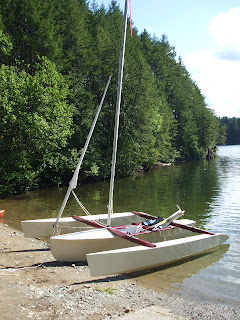Once I got parked in the lot, it took me awhile to get everything untied
 and laid out. First real work was the unfolding of the beams and bolting the hinges in place.
and laid out. First real work was the unfolding of the beams and bolting the hinges in place.I had practised the raising of the mast a number of times in my own yard, so that went easily too. I secured the stays and disconnected all my straps then backed down the ramp and slid the boat into the water. So exciting to finally see it afloat!

I left the rigging of the rudder and the main sail until the boat was on the beach. Took me awhile to swing the boat to get the stern in shallow enough water to pin the rudder and tie on the control lines. Raising the sail was more difficult as the wind was shifty in that little cove and the rising sail kept hanging up and pinching the bolt rope in the groove. Finally with the help of a friend who happened by, we got the sail up while keeping the boat pointed into the wind.

Took me a few minutes to organize all the lines piled in the rear cockpit, but finally I was aboard and given a push into the lake. I paddled further out of the cove and into the breeze. The boat sat as stable as a raft! A few tugs of lines locked both the rudder and the centerboard in place and I tightened the main sheet and felt the wind grab the sail.
A moment of fright as the boat heeled with the gust. Took me a little while to recall that every boat has to heel with the wind. That's what boats do!
I sailed around for awhile using only the main, getting used to the motions, the steering and the heeling. I am so used to a hand-held tiller, one that moved opposite to the intended direction, that I frequently steered the wrong way!
When I got comfortable again, I unfurled the jib and added more power. Then it got to be exciting. Lots of speed yet hardly any real motion of the boat due to small waves. The heeling of the boat settled in and I started to look for more wind, for more speed!
It felt like I was barely moving along when actually the GPS said I was at 4 knots. Just gliding! This was frantic top speed in my other boats! At about 6 knots, the rudder or the centerboard started to hum and add to the excitement. I presume that vibration is slowing me down, but for now, I don't care.
There was some rocking in boat wakes, but never any rolling if the sail was pulling.
I think the trip was a success as I had a terrific time and came home with a list of things to fix and alter. Can't wait to get back out there!

























